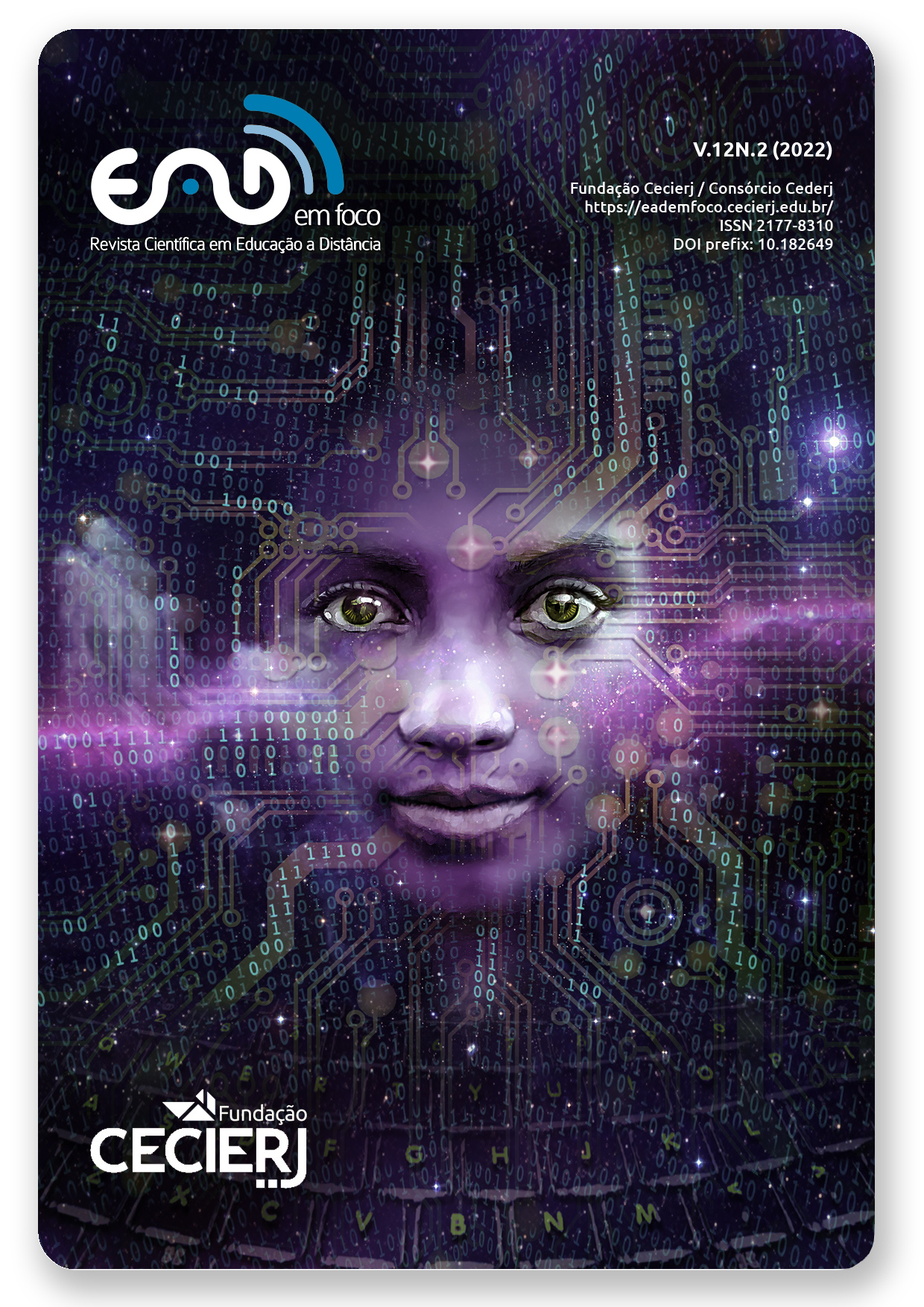Remote and Remote/In-Person Teaching from the Perspective of High-School Students during The COVID-19 Pandemics
DOI:
https://doi.org/10.18264/eadf.v12i2.1664Abstract
Due to the COVID-19 pandemics, contention measures were implemented by countries to slow the dissemination of the virus, leading to school and university closures. As an immediate solution in-person classes were moved to the online environment, then being referred to as "Remote Teaching", which has been a challenge both students and teachers are facing. In this context, this research examines the perception of high school students from private high schools in São Paulo regarding the quality of their education and the impacts on learning during the times of remote teaching and remote/in-person teaching. The data were collected using semi-structured interviews with five students from different high schools. The interviews took place in early 2021, when schools were returning to in-person classes, but had to adopt different strategies to stay in conformity with sanitary protocols. The analysis was focused on the high schools' organizational and infrastructural aspects, the teaching strategies that were adopted, their impact on learning, teacher-student relations, and students' social life. Our results show that between the years of 2020 and 2021, there were organizational rearrangements that caused considerable limitations to the learning process, not only from a technical perspective, but also pedagogically. We can infer that technology allowed for the continuation of the education process, but its potentialities were underused. We conclude that although the schools have taken an important step towards the usage of digital resources in teaching, the reformulation of their pedagogical projects is still essential to really integrate remote and in-person activities.
Keywords: Basic education. Remote teaching. Pandemics.
Downloads
References
ALMEIDA, B. O.; ALVES, L. R. G. Lives, Educação e COVID-19. Estratégias de Interação na Pandemia. Interfaces Científicas, Aracajú, v.10, n.1, p. 149-163, julho/2020.
ALVES, L. Educação Remota: Entre a Ilusão e a Realidade. Interfaces Científicas, Aracajú, v.8 n.3, p. 348-365, maio/2020.
BACICH, L.; NETO, A. T.; TREVISANI, F. M.; Ensino Híbrido: Personalização e tecnologia na educação. In: BACICH, L.; NETO, A.T.; TREVISANI, F.M (org.). Ensino Híbrido: Personalização e tecnologia na educação. Porto Alegre: Penso, 2015. p. 51-65.
BACICH, L.; MORAN, J.; FLORENTINO, E. Educação Híbrida: reflexões para a educação pós-pandemia. Políticas Educacionais em Ação – FGV EBAPE, Rio de Janeiro, nº 14, p. 1-13, abril/2021.
BEHAR, P. A. O ensino remoto emergencial e a educação a distância. Universidade Federal do Rio Grande do Sul. Jornal de Universidade, 2020. Disponível em: https://www.ufrgs.br/coronavirus/base/artigo-o-ensino-remoto-emergencial-e-a-educacao-a-distancia/ . Acesso em: 29 de janeiro de 2021.
BOWER, M. et al. Design and implementation factors in blended synchronous learning environments: Outcomes from a cross-case analysis. Computers & Education, Australia, v.86, p. 1-17, agosto/2015.
BRASIL. Ministério da Educação (MEC). Breve Diagnóstico da Educação Básica no contexto da Pandemia: Parecer Homologado Parcialmente. Brasília, 2020. Disponível em: https://www.in.gov.br/en/web/dou/-/portaria-n-343-de-17-de-marco-de-2020-248564376 . Acesso em: 3 de setembro de 2020.
CHARCZUK, S. B. Sustentar a Transferência no Ensino Remoto: docência em tempos de pandemia. Educação e Realidade, Porto Alegre, v. 45, n.4, p. 1-20, novembro/2020.
HUANG, Y. et al. Investigating and analyzing teaching effect of blended synchronous classroom. In: 2017 Internacional Conference of Educational Innovation through Technology (EITT). IEEE, 2017, Japan, p. 134-135.
KUPFERSCHIMIDT, K.; COHEN, J. Can China"™s COVID-19 strategy work elsewhere?. Science, Washington, v.367, n, p. 1061-1062, março/2020.
LUNA, A. A. Uma reflexão sobre a videoaula no contexto da EAD. Eutomia, Pernambuco, v.1, n.7, p. 272-285, 2011.
MARTíNS-NÚÑEZ, J. L. et al. Teaching in Secondary Education Teacher Training with a Hybrid Model: Students"™ Perception. Sustainability, v. 14, n. 6, p. 3272, março/2022.
MORAN, J. Educação Híbrida: Um conceito-chave para a educação, hoje. In: BACICH, L.; NETO, A. T.; TREVISANI, F. M. Ensino Híbrido: Personalização e tecnologia na educação. Porto Alegre: Penso, 2015. p. 27-44.
MORAN, 2018. Metodologias ativas para uma aprendizagem mais profunda. In: BACICH, L.; MORAN, J. Metodologias ativas para uma educação inovadora: uma abordagem teórico-prática. Porto Alegre: Penso, 2018. p. 2-26.
PEREIRA, R. M. S. et al. Vivência de estudantes universitários em tempos de pandemia do Covid-19. Práxis, Volta Redonda - RJ, v. 12, n.1, p. 47-54, dezembro/2020.
RAES, A. et al. Learning and instruction in the hybrid virtual classroom: An investigation of students"™engagement and the effect of quizzes. Computers & Education, Belgium, v. 143, p. 1/16, janeiro/2020.
RAES, A. Exploring Students and Teacher Experiences in Hybrid Learning Environments: Does Presence Matter?. Postdigital Science and Education, v. 4, n.1, p. 138-159, janeiro/2022.
RIBEIRO, C. H. V.; CAVALCANTI, M. T.; FERREIRA, A. P. "Abre a Câmera, por favor!": Aulas Remotas no Ensino Superior, uma Abordagem Fenomenológica. EaD em foco, Rio de Janeiro, v.11, n.2, p. 1-14, março/2021.
ROCHA, T. B. O Plano de Aula para Educação On-line na Pandemia de COVID-19. EaD em Foco, v.11, n.2, p. 1-13, maio/2021.
RONDINI, C. A.; PEDRO, K. M.; DUARTE, C. S. F. Pandemia da COVID-19 e o Ensino Remoto Emergencial: Mudanças na Prática Docente. Interfaces Científicas, Aracajú, v.10, n.1, p. 41-47, setembro/2020.
SANTANA, C. L. S.; SALES, K. M. B. Aulas em Casa: Educação, Tecnologias Digitais e Pandemia COVID-19. Interfaces Científicas, Aracajú, v.10, n.1, p. 76-91, julho/2020.
TODOS PELA EDUCAÇíO. Nota técnica: Ensino a distância na educação básica frente í pandemia da COVID-19. São Paulo, 2020. Disponível em: https://www.todospelaeducacao.org.br/_uploads/_posts/425.pdf . Acesso em: 3 de setembro de 2020.
TRINDADE, S. D.; CORREIA, J. D.; HENRIQUES, S. O Ensino Remoto Emergencial na Educação Básica Brasileira e Portuguesa: A Perspectiva dos Docentes. Tempos e Espaços em Educação, Sergipe, v.13, n.31, p. 1-23, novembro/2020.
VIEIRA, K. M. et al. Vida de Estudante Durante a Pandemia: Isolamento Social, Ensino Remoto e Satisfação com a Vida. EaD em foco, Rio de Janeiro, v. 10, n.3, p. 1-15, setembro/2020.
WHO - World Health Organization. Director-General"™s opening remarks at the media briefing on COVID-19 – 11 March 2020. Disponível em : https://www.who.int/director-general/speeches/detail/who-director-general-s-opening-remarks-at-the-media-briefing-on-covid-19---11-march-2020 . Acesso em: 5 de setembro de 2020.
ZYDNEY, J. M. et al. Here or there instruction: Lessons learned in implementing innovative approaches to blended synchronous learning. Techtrends, U.S , v. 63, n. 2, p. 123-132, outubro/2019.
Downloads
Published
How to Cite
Issue
Section
License
Copyright (c) 2022 EaD em Foco

This work is licensed under a Creative Commons Attribution 4.0 International License.
All articles published in Revista EaD em Foco receive the license
Creative Commons - Atribuição 4.0 Internacional (CC BY 4.0).
All subsequent publications, complete or partial, must be made with the acknowledgment, in citations, of the Revista EaD em Foco as the original editor of the article.













